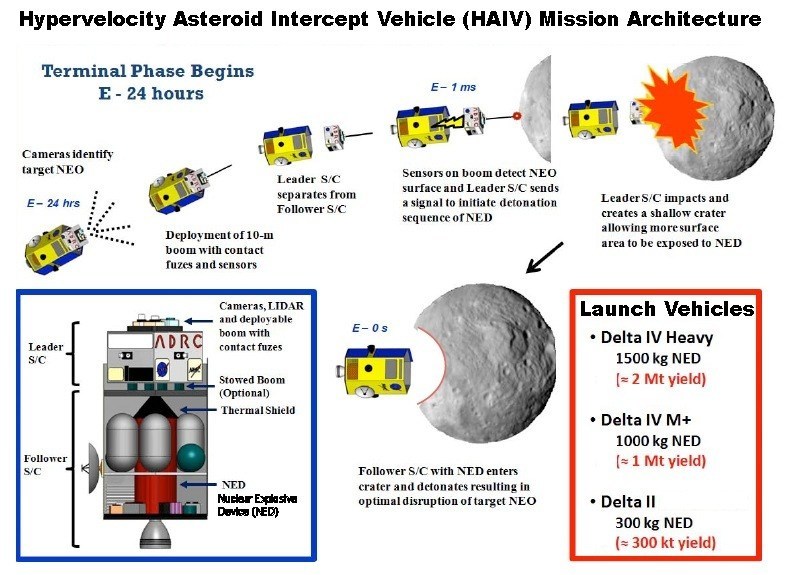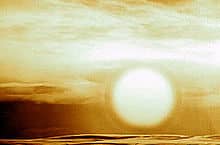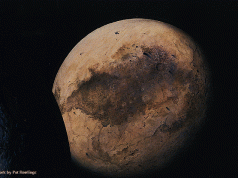JUST ONE SOLUTION. NUCLEAR ENERGY:
Nuclear energy, because of the basic reason that, by a factor of a million, nuclear energy is the greatest energy source we have. This is why the main problem of our civilization has become the problem of nuclear energy. How to use it appropriately, and not freak out.
If the comet were heading towards Earth we would be scrambling to put together a giant thermonuclear weapon. It could be done. The French republic, by itself, could do it, using in-house equipment. The chance of success, though would approach 100% if, and only if, one were to prepare well, in an international program.
Lots of Uranium 235, and Lithium 7, for a bigger bang, in the monster fission-fusion-fission thermonuclear device we would be hastening to prepare. One of several (because we would need back-ups). If we were really pressed for time, we could rigged together several conventional nuclear warheads, packed together to explode simultaneously.
As NASA puts it in 2012: For non-technical reasons, this would likely be a last resort, but IT IS ALSO THE MOST POWERFUL TECHNIQUE and could take several different forms, as discussed in the report. The nuclear option would be usable for objects up to a few kilometers in diameter.
The efficiency of a thermonuclear explosion is augmented by an order of magnitude if it happens three meters below the surface rather than on contact, one centimeter above the surface. So NASA (2012) has proposed to extend the Nuclear Explosive Device with a frontal penetrator which would create a three meter crater. Easy computations show that, had the hyperbolic comet headed towards Earth, the interception speed would have been at least 80km/s, meaning that the thermonuclear fusion sequence would have to be started just before first contact.

Of the shelf H bombs could take care of comets a few kilometers across.
The power of nuclear devices is hard to fathom. The Castle Bravo device made a crater in the atoll reef. Although it was exploded 7 feet above the reef, the crater had a diameter of 2 kilometers (6510 ft), with a depth of 80 meters (250 ft). It would have been much worse if it had been buried by 3 meters (five kilometers across, 160 meters deep).
For larger comets, a true bomb from hell would have to be devised: a fission-fusion-fission with a powerful third stage. A third stage is simply a Uranium envelope around the thermonuclear bomb. When it gets hit by “fast neutron” from the H bomb, it fissions in turn. The largest bomb ever tested, Tsar Bomba, over the arctic island of Novaya Zemlya, was 58 megatons TNT. It was deliberately made with NO third stage. (And the second stage may have contained some lead, instead of uranium.)
It’s not that a third stage is hard to make; it’s just uranium metal. But Soviet physicists computed that, with a third stage, Tsar Bomba would have been too powerful. The plane dropping the bomb and its parachute would have been destroyed, to start with. As it was windows were broken more than 1,000 kilometers away, in Finland and Norway. Because so little uranium was used, relative to the Lithium Deuteride fusion fuel, the mightiest bomb ever was also the cleanest, ever, at 97% pure fusion. (Fusion is cleaner because it fuses light elements to create slightly heavier, but still light, elements, and light elements tend not to be fission, or then not for long.)
By enriching the third stage tamper with U235, one could probably go beyond 200 Megatons (and such a tamper could be rigged around conventional warheads, too!).
Thus, contrarily to urban legend from luddites in denial, the largest thermonuclear bombs could take care of the largest comets.

The largest comets are 60% larger than the entire picture, if one uses the fireball as a measuring unit.
Even the largest comet would fragment and the pieces would rocket away. If done a few weeks before Earth impact, clearly all the pieces would miss (another rocket or two would be in back up, just in case).
BACK TO THE CATASTROPHE SCENARIO:
So let’s suppose again that C would be headed towards Earth instead of mars.
The next Ariane V would have to be modified hastily. Why Ariane V? First, that flight is already being assembled. It is Flight VA213, signifying the 213th launch of an Ariane from French Guiana since the family’s maiden liftoff in 1979. Its Automatic Transfer Vehicle, named Albert Einstein, would have to be modified with a booster, interception electronic package and basically a boom system in the front to detonate fast enough the nuke in the back, at the staggering speeds involved, so that the bomb can explode at 3 meter depth in the comet. 200 megatons against 20 billion megatons. Fun. Unreal reality.
In general, Ariane is the most dependable, most frequently launched rocket in the West’s arsenal. So it should be part of the quick reaction force to be assembled, as one would need to fling a hefty load.
IS IT ALL REAL?
When “experts” come, and talk about the frequency of impacts, the truth is that we do not have any idea what it is, up to a factor of ten, or more. It is certainly higher than what experts used to believe. three cometary impacts, or near impacts of comets on planets close to us in 20 years is a bad omen.
I was listening to National Public Radio where some scientist from John Hopkins pontificated that the asteroid strike in Siberia (which, a few tens of seconds off could well have annihilated a major city) happened only every century. In truth, on land three impacts about ten times bigger are known in the last century. Scaling with the ocean, one gets nearly ten of these ten times bigger impacts. Not to say that this is the long term average: it could be a fluke. The same stupid guy was saying that, if we had only 6 months warning, we could not do anything.
And he works on preventing impacts! NPR said.
But what he forgot to say is that his program strictly uses the explosive technology Genghis Khan already had at his disposal. (And what happened? After a costly victory in Hungary, the Tumens had to turn back, them and their fancy black powder rockets.)
(Scientists should stop pontificating, or talk as if they knew, when they don’t, reserve that to the Pope.)
There may have been other impacts in historical times. Unrecorded.
Strange events happening in the Sixth Century, recorded by Chinese and Romans (the only civilizations recording anything reliably at the time) could be explained by impact(s) at sea. (Or then a large volcanic eruption, unidentified so far.) Those events, whatever they were, altered the climate.
Some will smirk, and ask to see the craters. Celestial bodies colliding with the Earth are not on any kind of trajectories. They are ruled by the sun, that is they tend to have trajectories similar to the Earth, but at an angle. So a typical impact will involve a low angle atmospheric entry, spreading death, fires, shock waves and devastation for thousands of kilometers. A crater will not necessary form (elongated craters have been found in Argentina). And remember, 2/3 of Earth is water.
Speaking of which, a proposed impact, the Mahuika impact, 1443 CE, off the south coast of New Zealand, would have been gigantic, typical of a mini comet 500 meters across. There is some evidence for such a cometary impact, from the existence of a crater, from Maori evacuation of the area, to suspected tektites, to suspicious ice cores in Antarctica, to megatsunamis, up to 220 meters high in the region (and 143 meters high in Australia). https://en.wikipedia.org/wiki/Mahuika_crater
So much for these things being rare.
CHANGE THE MOOD ABOUT MOODS:
In recapitulation: learn to do what you can do about what matters.
Lord Martin Rees, Astronomer Royal, Nobel Laureate, etc. in Science Mag. editorial “Denial of Catastrophic Risks”, March 8, 2013: “In a media landscape saturated with sensational Science stories and “End of the World” Hollywood productions, it may be hard to persuade the wide public that real catastrophes could arise as unexpectedly as the 2008 financial crisis, and have a far greater impact. Society could be dealt shattering blows by the misapplication of technologies that exist already . we should be more concerned about events that have not yet happened but which, if they occurred even once, could cause worldwide devastation.”
What Rees is saying is that we should change MOODS. We should change our system of mood. Preparing for a comet impact, and how to defeat it would help to change the mood we have about moods.
We need to learn to deny our Denial of Catastrophic Risks.
And we learn to do something about catastrophic risks we have identified (I call this new way of thinking catastrophic calculus). Having an active Spaceguard program against asteroids and comets of all sizes and origins, hyperbolic or not, would be a good symbol of the new attitude we need to adopt. Besides, it would reduce unemployment, and push technology forward. That’s appropriate.
*
Patrice Ayme





